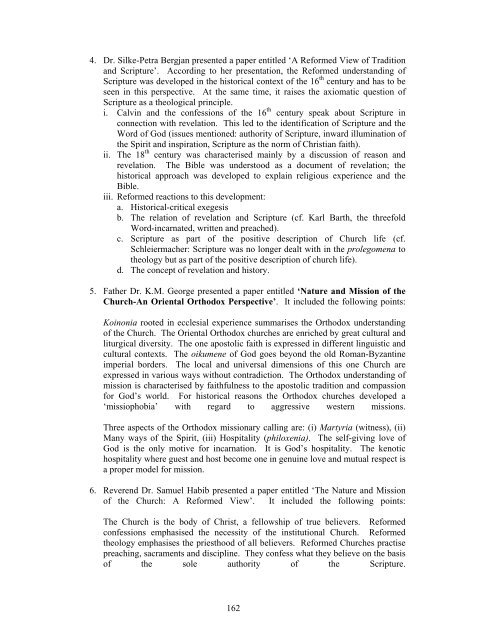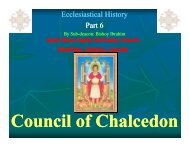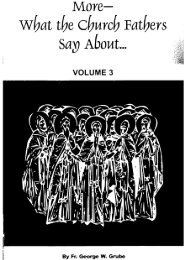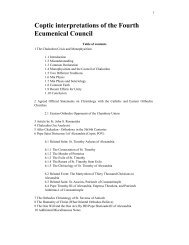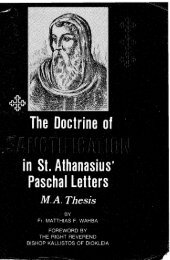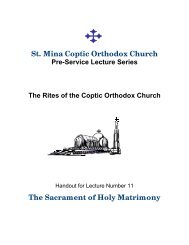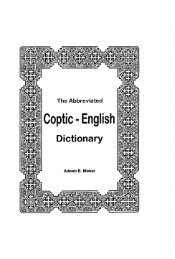Coptic Church & Ecumenical Movement - Saint Mina Coptic ...
Coptic Church & Ecumenical Movement - Saint Mina Coptic ...
Coptic Church & Ecumenical Movement - Saint Mina Coptic ...
Create successful ePaper yourself
Turn your PDF publications into a flip-book with our unique Google optimized e-Paper software.
4. Dr. Silke-Petra Bergjan presented a paper entitled ‘A Reformed View of Tradition<br />
and Scripture’. According to her presentation, the Reformed understanding of<br />
Scripture was developed in the historical context of the 16 th century and has to be<br />
seen in this perspective. At the same time, it raises the axiomatic question of<br />
Scripture as a theological principle.<br />
i. Calvin and the confessions of the 16 th century speak about Scripture in<br />
connection with revelation. This led to the identification of Scripture and the<br />
Word of God (issues mentioned: authority of Scripture, inward illumination of<br />
the Spirit and inspiration, Scripture as the norm of Christian faith).<br />
ii. The 18 th century was characterised mainly by a discussion of reason and<br />
revelation. The Bible was understood as a document of revelation; the<br />
historical approach was developed to explain religious experience and the<br />
Bible.<br />
iii. Reformed reactions to this development:<br />
a. Historical-critical exegesis<br />
b. The relation of revelation and Scripture (cf. Karl Barth, the threefold<br />
Word-incarnated, written and preached).<br />
c. Scripture as part of the positive description of <strong>Church</strong> life (cf.<br />
Schleiermacher: Scripture was no longer dealt with in the prolegomena to<br />
theology but as part of the positive description of church life).<br />
d. The concept of revelation and history.<br />
5. Father Dr. K.M. George presented a paper entitled ‘Nature and Mission of the<br />
<strong>Church</strong>-An Oriental Orthodox Perspective’. It included the following points:<br />
Koinonia rooted in ecclesial experience summarises the Orthodox understanding<br />
of the <strong>Church</strong>. The Oriental Orthodox churches are enriched by great cultural and<br />
liturgical diversity. The one apostolic faith is expressed in different linguistic and<br />
cultural contexts. The oikumene of God goes beyond the old Roman-Byzantine<br />
imperial borders. The local and universal dimensions of this one <strong>Church</strong> are<br />
expressed in various ways without contradiction. The Orthodox understanding of<br />
mission is characterised by faithfulness to the apostolic tradition and compassion<br />
for God’s world. For historical reasons the Orthodox churches developed a<br />
‘missiophobia’ with regard to aggressive western missions.<br />
Three aspects of the Orthodox missionary calling are: (i) Martyria (witness), (ii)<br />
Many ways of the Spirit, (iii) Hospitality (philoxenia). The self-giving love of<br />
God is the only motive for incarnation. It is God’s hospitality. The kenotic<br />
hospitality where guest and host become one in genuine love and mutual respect is<br />
a proper model for mission.<br />
6. Reverend Dr. Samuel Habib presented a paper entitled ‘The Nature and Mission<br />
of the <strong>Church</strong>: A Reformed View’. It included the following points:<br />
The <strong>Church</strong> is the body of Christ, a fellowship of true believers. Reformed<br />
confessions emphasised the necessity of the institutional <strong>Church</strong>. Reformed<br />
theology emphasises the priesthood of all believers. Reformed <strong>Church</strong>es practise<br />
preaching, sacraments and discipline. They confess what they believe on the basis<br />
of the sole authority of the Scripture.<br />
162


